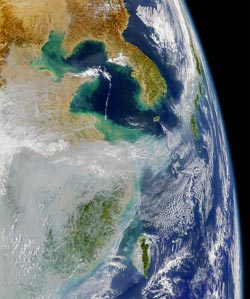Air Pollution From Asia Affecting World’s Weather

NASA/JPL<br><br>Satellite photo shows huge air pollution clouds at far left. Japan is on the right.<br>
Yuan Wang, a former doctoral student at Texas A&M, along with Texas A&M atmospheric sciences professors Renyi Zhang and R. Saravanan, have had their findings published in the current issue of Nature Communications.
Using climate models and data collected about aerosols and meteorology over the past 30 years, the researchers found that air pollution over Asia – much of it coming from China – is impacting global air circulations.
“The models clearly show that pollution originating from Asia has an impact on the upper atmosphere and it appears to make such storms or cyclones even stronger,” Zhang explains.
“This pollution affects cloud formations, precipitation, storm intensity and other factors and eventually impacts climate. Most likely, pollution from Asia can have important consequences on the weather pattern here over North America.”
China’s booming economy during the last 30 years has led to the building of enormous manufacturing factories, industrial plants, power plants and other facilities that produce huge amounts of air pollutants. Once emitted into the atmosphere, pollutant particles affect cloud formations and weather systems worldwide, the study shows.
Increases in coal burning and car emissions are major sources of pollution in China and other Asian countries.
Air pollution levels in some Chinese cities, such as Beijing, are often more than 100 times higher than acceptable limits set by the World Health Organization standards, Zhang says.
One study has shown that lung cancer rates have increased 400 percent in some areas due to the ever-growing pollution problem.
Conditions tend to worsen during winter months when a combination of stagnant weather patterns mixed with increased coal burning in many Asian cities can create pollution and smog that can last for weeks. The Chinese government has pledged to toughen pollution standards and to commit sufficient financial resources to attack the problem.
“The models we have used and our data are very consistent with the results we have reached,” Saravanan says.
“Huge amounts of aerosols from Asia go as high as six miles up in the atmosphere and these have an unmistakable impact on cloud formations and weather.”
Zhang adds that “we need to do some future research on exactly how these aerosols are transported globally and impact climate. There are many other atmospheric observations and models we need to look at to see how this entire process works.”
Yuan Wang, who conducted the research with Zhang while at Texas A&M, currently works at NASA’s Jet Propulsion Laboratory as a Caltech Postdoctoral Scholar.
The study was funded by grants from NASA, Texas A&M’s Supercomputing facilities and the Ministry of Science and Technology of China.
Media contact: Keith Randall, News & Information Services, Texas A&M, at (979) 845-4644 or keith-randall@tamu.edu or Renyi Zhang at (979) 845-7656 or zhang@ariel.met.tamu.edu or R. Saravanan at (979) 845-0175 or sarava@tamu.edu or Alan Buis, JPL media contact, at (818) 354-0474 or alan.d.lbuis@jpl.nasa.gov
For more news about Texas A&M University, go to http://tamutimes.tamu.edu/
Follow us on Twitter at https://twitter.com/TAMU
Media Contact
More Information:
http://www.tamu.eduAll latest news from the category: Earth Sciences
Earth Sciences (also referred to as Geosciences), which deals with basic issues surrounding our planet, plays a vital role in the area of energy and raw materials supply.
Earth Sciences comprises subjects such as geology, geography, geological informatics, paleontology, mineralogy, petrography, crystallography, geophysics, geodesy, glaciology, cartography, photogrammetry, meteorology and seismology, early-warning systems, earthquake research and polar research.
Newest articles

Silicon Carbide Innovation Alliance to drive industrial-scale semiconductor work
Known for its ability to withstand extreme environments and high voltages, silicon carbide (SiC) is a semiconducting material made up of silicon and carbon atoms arranged into crystals that is…

New SPECT/CT technique shows impressive biomarker identification
…offers increased access for prostate cancer patients. A novel SPECT/CT acquisition method can accurately detect radiopharmaceutical biodistribution in a convenient manner for prostate cancer patients, opening the door for more…

How 3D printers can give robots a soft touch
Soft skin coverings and touch sensors have emerged as a promising feature for robots that are both safer and more intuitive for human interaction, but they are expensive and difficult…




















